Key takeaways:
- Licensing partnerships offer independent labels a way to expand reach, generate revenue, and promote artists without heavy production costs.
- Successful partnerships require thorough research on potential partners’ values, audience demographics, and past collaborations to ensure alignment.
- Effective proposals should focus on storytelling, clarity, and appealing visuals to enhance engagement and emotional connection with potential partners.
- Maintaining partnerships involves ongoing communication, celebrating milestones, and being open to feedback to foster trust and collaboration.
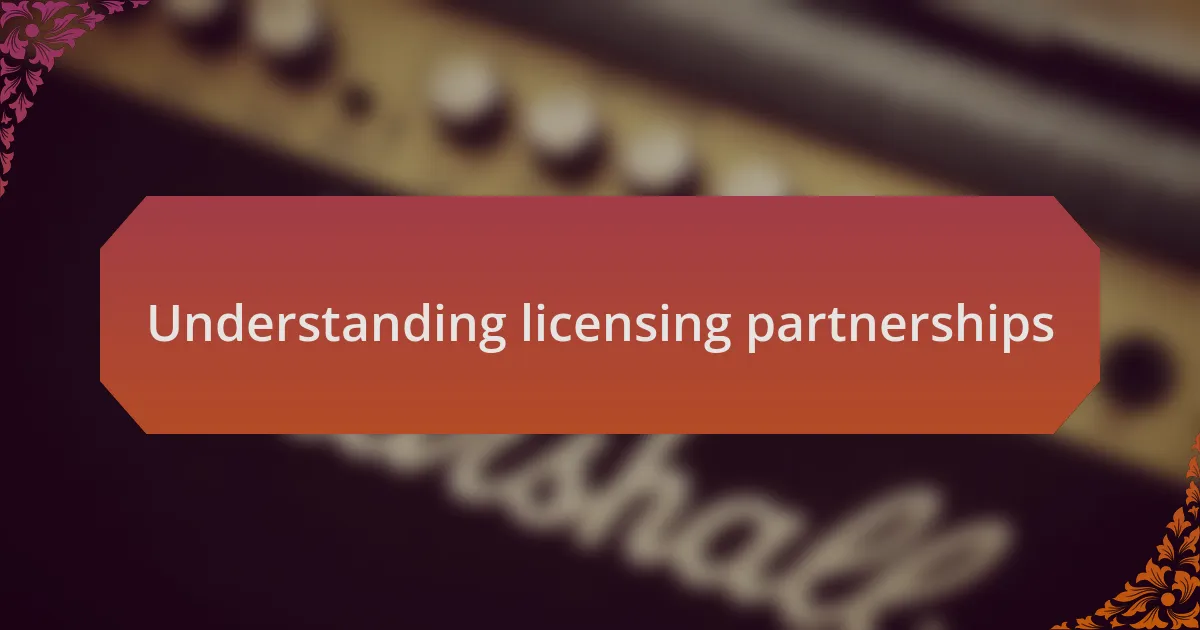
Understanding licensing partnerships
Licensing partnerships are crucial in the music industry, especially for independent record labels. I remember the first time I secured a licensing deal; it felt like I was finally gaining a foothold in a landscape that often seems daunting. It’s a powerful way to expand your reach without the heavy costs of production or the risk of losing creative control.
Have you ever thought about how much music is out there waiting to be discovered? Licensing partnerships allow independent labels to tap into existing markets while promoting new talents. By collaborating with filmmakers or advertisers, I found it incredible to see how my artists’ sounds could elevate visual stories, creating an emotional connection that resonates deeply with audiences.
Navigating the world of licensing can be complex, filled with legal jargon and negotiations. When I first started, I felt overwhelmed, but I quickly realized that forming these partnerships is less about legalese and more about storytelling and mutual benefit. I ask you—how can your music tell a story that others want to share? Finding that common ground is the key to successful licensing.
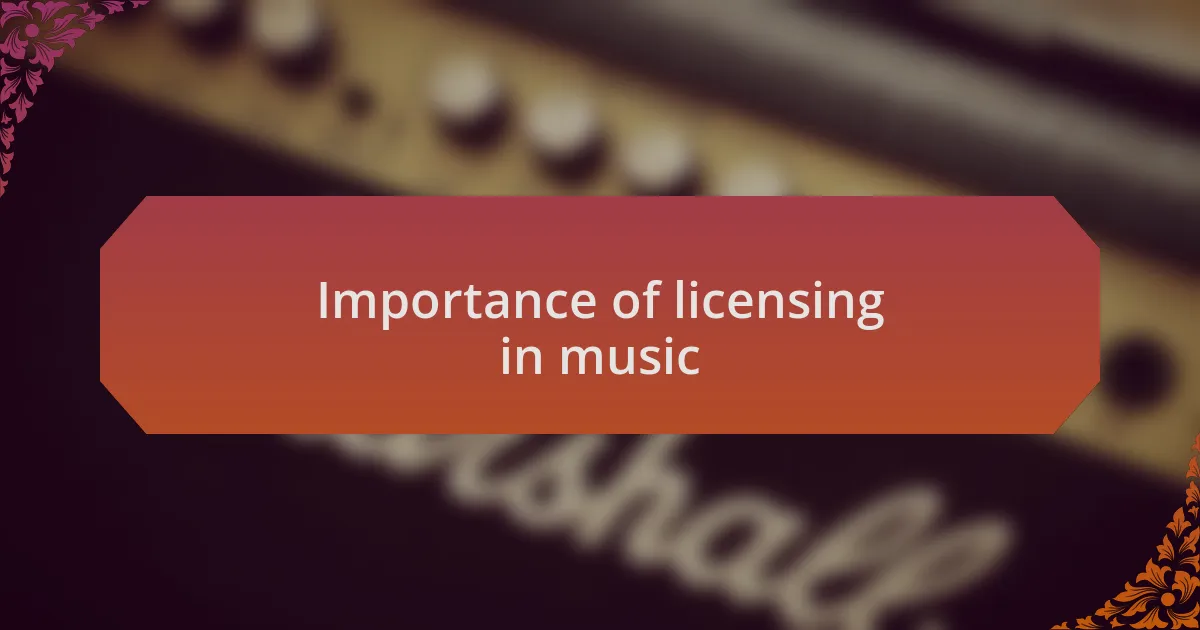
Importance of licensing in music
Licensing in music is not just about legality; it’s about opportunity. I recall when one of my artists’ tracks was picked up for a well-known brand’s commercial. The excitement was palpable—not only did it give her exposure, but it also brought a validation that artists crave. That synergy between music and brand can create magic, turning a simple advertisement into a memorable experience.
One key aspect that often gets overlooked is how licensing helps in revenue generation. I’ve often seen independent labels struggle with finances, and this is where licensing offers a lifeline. It provides a new stream of income, which can be reinvested into the artist’s development. Can you imagine how those extra funds could assist in producing a new album or funding a tour?
Moreover, the emotional weight that licensed music carries can’t be understated. When I hear one of my tracks in a film scene, I feel a rush of pride. That moment illustrates the power of music to evoke feelings and enhance storytelling. Have you ever experienced a song that resonated with you during a pivotal moment in a movie? That’s the beauty of licensing; it connects the artist’s vision with wider narratives, making both the music and the visuals unforgettable.
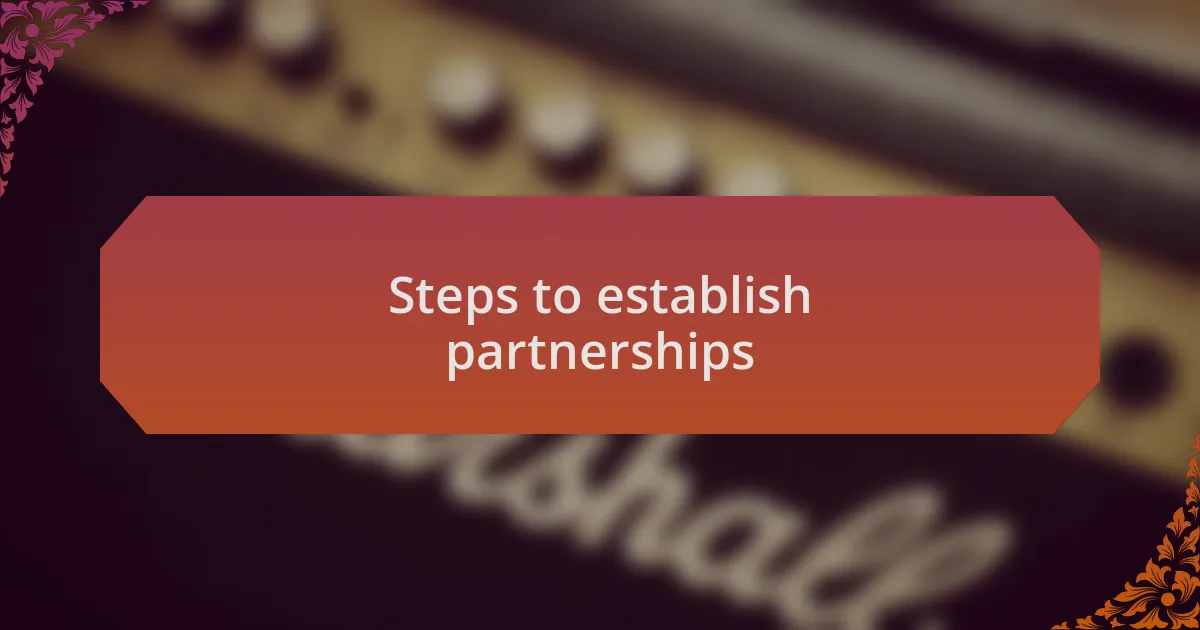
Steps to establish partnerships
Building successful licensing partnerships starts with research. I’ve often taken the time to understand which brands align with my artists’ values and music styles. For instance, when I explored a partnership with a sustainable clothing line, the collaboration felt authentic. It made me wonder—how often do we check if our artists’ ethics match those of potential partners?
Once you have a shortlist of potential partners, the next step involves crafting personalized pitches. I remember a time when I reached out to a gaming company about a soundtrack. I tailored my approach to highlight how the immersive experience of my artist’s music could enhance their game. The result? A fruitful partnership that not only benefited both sides but also resonated with gamers on a deeper level. What if I hadn’t taken that extra step to connect the dots?
Finally, maintaining those partnerships is crucial. Regular communication with partners allows for nurturing and growth, creating a solid foundation for future collaborations. I make it a point to check in, celebrate milestones, and discuss new opportunities. Have you ever experienced the difference that personal touch makes in any relationship? In the long run, it’s not just about securing a deal; it’s about fostering a lasting connection that thrives on shared success.
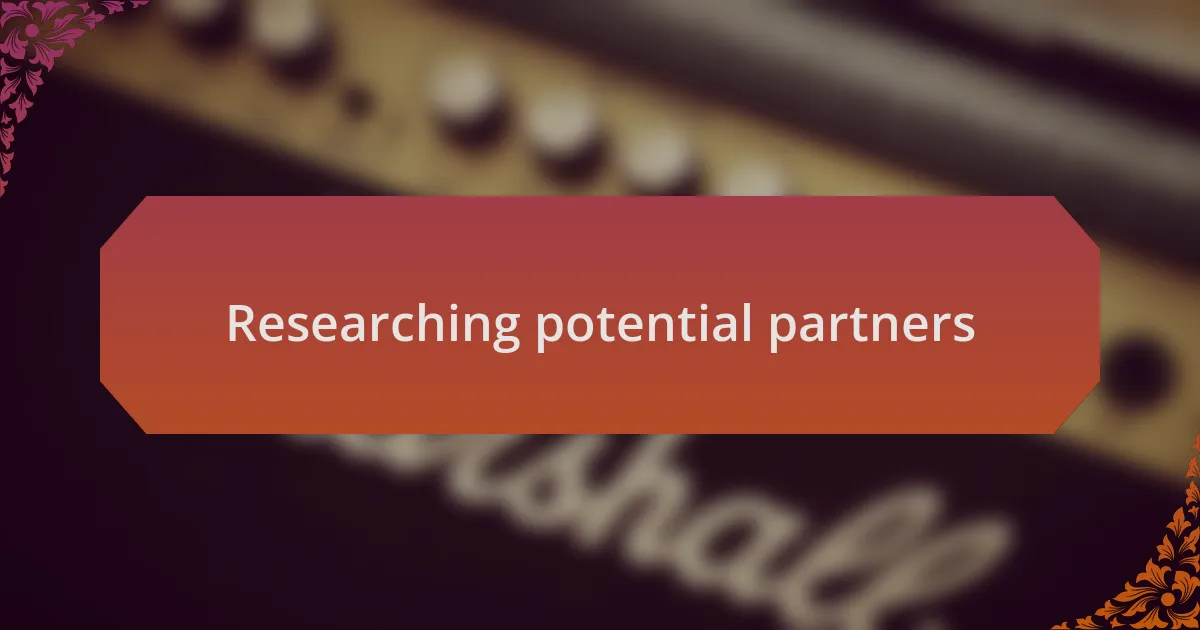
Researching potential partners
When researching potential partners, I dive deep into their brand’s narrative and values. For instance, I recall my excitement while reviewing a local food festival that aimed to promote organic products. Understanding their commitment to sustainability made me realize how well they matched one of my artist’s messages about eco-friendly living. It’s essential to ask yourself: does this partnership feel genuine?
Another aspect I consider is their audience demographics. During one project, I analyzed a lifestyle brand catering to young adults. Their target audience aligned perfectly with my artist’s fanbase, creating a win-win opportunity. Have you ever stopped to think about how impactful it is when your artist’s message reaches a community that can truly resonate with it?
I also pay attention to a potential partner’s past collaborations. I remember stumbling upon a record label’s partnership with a well-known beverage brand. Their synergy not only amplified their artists’ exposure but also sparked creativity that left a lasting impression on listeners. This made me contemplate: how can I learn from their experiences to enhance my own partnerships? Keeping these elements in mind can lead to fruitful and authentic collaborations.
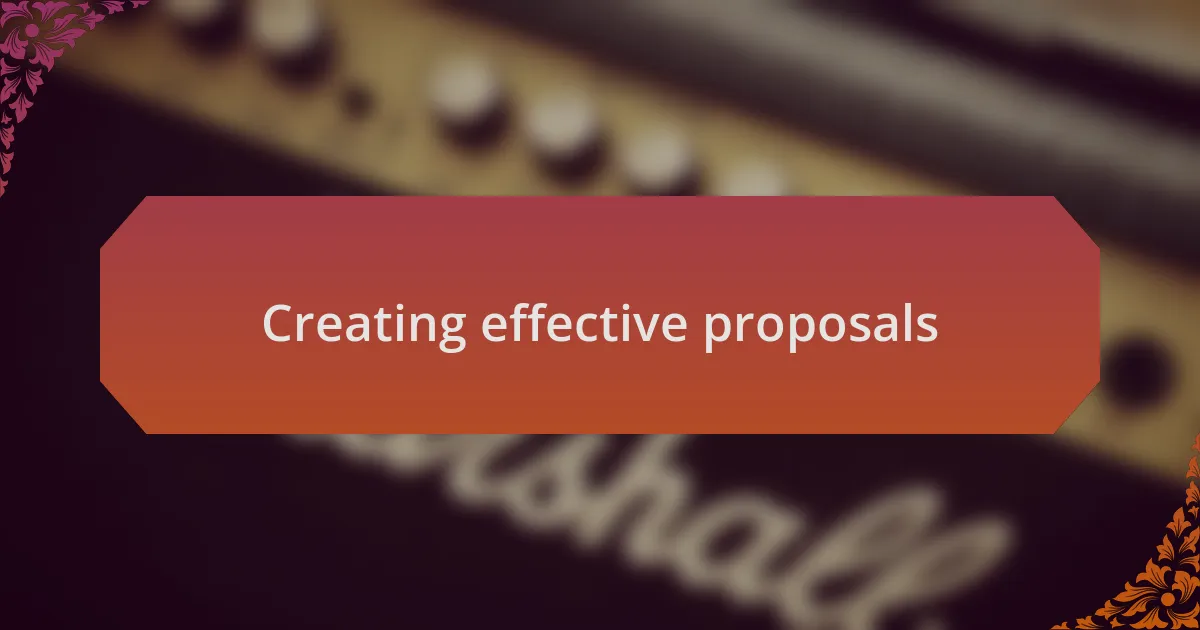
Creating effective proposals
Creating effective proposals requires a keen understanding of both your vision and that of your potential partner. I recall a time when I crafted a proposal for a joint project with an up-and-coming fashion brand. By weaving in my artist’s story and aligning it with the brand’s ethos, I ensured the proposal felt more like a narrative than just cold facts. Have you ever noticed how storytelling can breathe life into a proposal?
When tailoring your proposal, clarity is key. During one collaboration, I learned the hard way that overly complex jargon can alienate potential partners. I once simplified my pitch after receiving feedback from a partner who felt overwhelmed by technical terms. This adjustment not only made the proposal more engaging but also solidified the partnership. How do you think simplifying your message can change the way potential partners perceive your vision?
Lastly, don’t underestimate the power of visuals in your proposals. I remember including vibrant images and design elements in a pitch for an outdoor festival partnership. It transformed my proposal from a plain document into a stunning representation of what we could achieve together. Have you ever considered how visuals can elevate your presentation? Such details can create an emotional connection and make your proposal stand out in a sea of text.
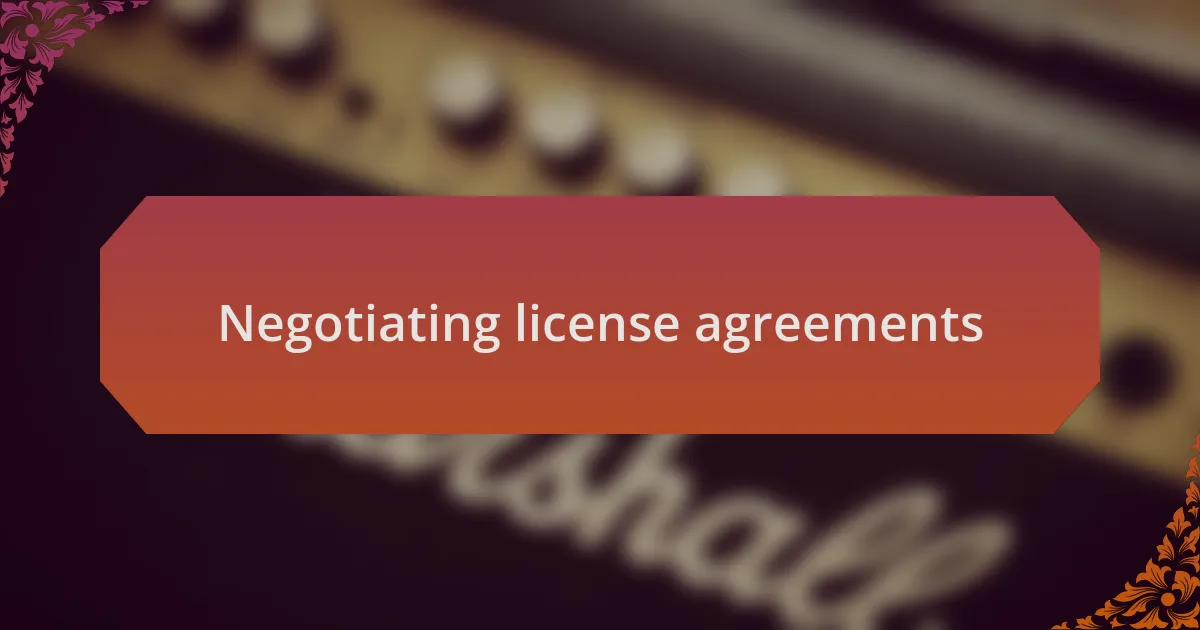
Negotiating license agreements
Negotiating license agreements can feel like walking a tightrope between collaboration and business. I recall a particularly intense negotiation with a tech company aiming to license one of my artist’s tracks for their promotional campaign. It was crucial for me to advocate for adequate financial terms while ensuring my artist maintained creative control. Have you faced a moment where you had to balance your needs with those of a partner?
Understanding the partner’s perspective is vital. During one negotiation, I made a point to listen actively, which revealed that their primary concern was the track’s exclusivity. By addressing their fears and proposing a tiered licensing model, we not only arrived at a mutually beneficial agreement but also built a stronger relationship. How often do we overlook the power of empathy in negotiations?
Lastly, always be prepared to walk away if the terms don’t align with your goals. I once found myself at an impasse during a licensing discussion when the proposed royalties felt inadequate. Rather than compromising my values, I calmly expressed my reservations and highlighted how a fair agreement would foster a more productive partnership in the long run. This decisive moment underscored for me that holding firm can sometimes lead to even better opportunities. What would you prioritize if a negotiation testing your principles arose?
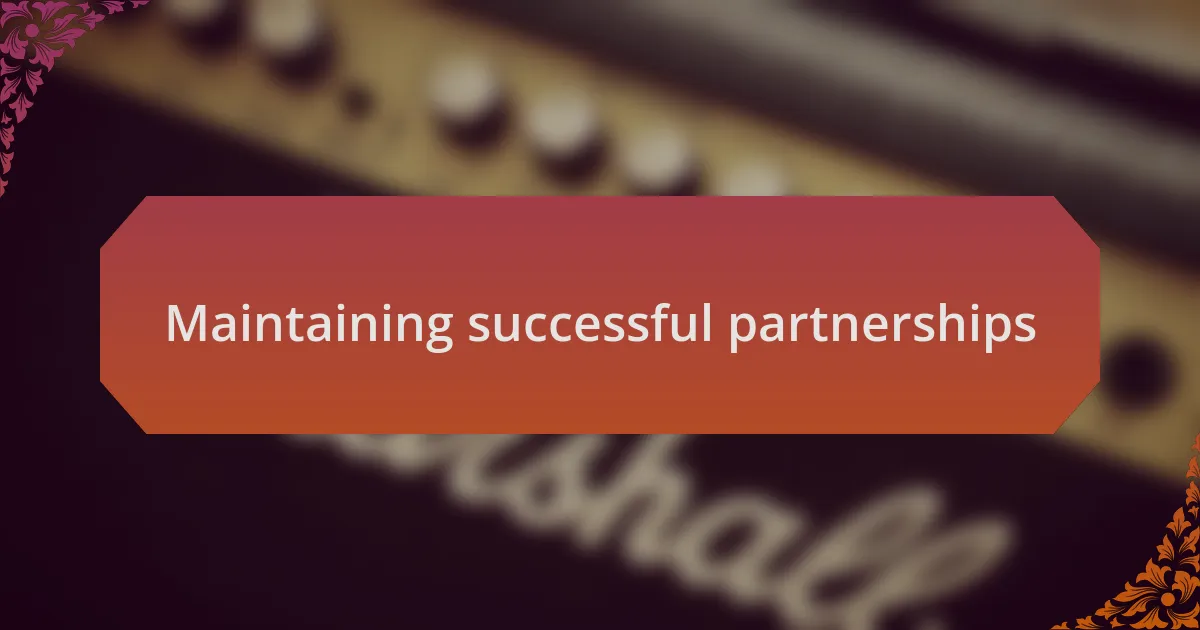
Maintaining successful partnerships
Successful partnerships require ongoing communication and trust. I remember a time when a relationship with a licensing partner began to falter due to misunderstandings about project timelines. By initiating a candid conversation, we were able to clarify expectations and re-align our objectives, ultimately reinforcing the partnership. Have you considered how regular check-ins could strengthen your own collaborations?
It’s essential to celebrate milestones together. After a successful campaign featuring one of my artists’ tracks, I organized a small gathering to acknowledge the hard work from both sides. This gesture not only fostered goodwill but also solidified our commitment to future projects. How often do we take the time to recognize achievements in our partnerships?
Lastly, being open to feedback is crucial for maintaining a strong partnership. I recall receiving constructive criticism from a licensing partner regarding marketing strategies. Initially, it stung a bit, but I realized their perspective could enhance our approach. As challenging as it may be, embracing feedback and adapting shows partners that you value their insights, which often leads to even greater success together. Would you be willing to reconsider your approach if it meant strengthening a key partnership?